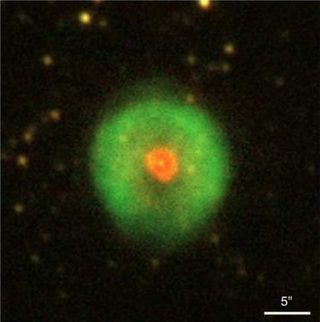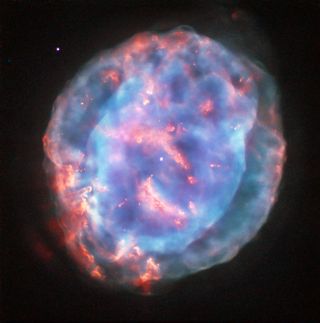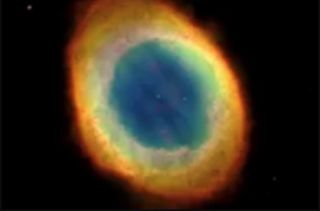This Strange Nebula Looks Inside Out and Born-Again

The nebula of a dying star has a "inside-out" appearance, scientists announced in a new study — and this may be our sun's ultimate fate.
Four years ago, astronomer Martín Guerrero from the Astrophysics Institute of Andalucía in Granada, Spain, discovered something puzzling: The shell-shaped remains of a stellar explosion — known as a planetary nebula — looked like it was inside out and seemingly born-again in a rare cosmic occurrence.
"I was at a telescope in La Palma, a beautiful island here in Spain, and I was repeatedly making images of planetary nebulas," Guerrero told Space.com. [Glowing Nebula Decorates Space in Hubble Image]

When Guerrero first looked at the planetary nebula HuBi1, things seemed normal.
"I made the image in the high-ionization filter; I saw some structures, nothing very impressive," he said. But then things got surprising. "The image in the low-ionization stage was something completely crazy. So my first idea was that I'm sleepy and I used the wrong filter!"
Ionization occurs in all planetary nebulas; it's a phenomena by which the radiation of an energetic central star strips electrons off atoms in the clouds of dust and gas. "In almost all cases, atoms closer to the intense light source are likely to have more of their electrons stripped than do atoms further away," Bruce Balick, an astronomer at the University of Washington and a close collaborator on other projects with Guerrero, told Space.com in an email.
But HuBi1 showed unusual high ionization at the outside edge of the shell shape, and low ionization near the center.
Get the Space.com Newsletter
Breaking space news, the latest updates on rocket launches, skywatching events and more!
After more scientists came on board to perform other tests, like stellar evolutionary modelling, Guerrero and his team put the pieces of the HuBi1 puzzle together.
And to explain, Guerrero used a fruit.

"Imagine the center of a star of a planetary nebula is something like an apple. So you have most of the apple is the flesh, and there is a very thin skin. Imagine that the star, this apple, is mostly carbon and oxygen," he said.
"This inner material is never going to get to the pressure and to the temperature where the carbon and oxygen are going to start fusing ... so this is very stable." [Ghost of a Dying Star Hints at Sun's Future]
Then, Guerrero discusses the skin of this astronomical apple.
"The skin is hydrogen and helium. In 80 to 90 percent of the cases, nothing is going to happen: The star at this stage is getting its energy from burning hydrogen on the surface of the star into helium. But, in about 10 or 15 percent of the cases, this helium layer is going to get to a critical mass.
"At this critical mass," Guerrero said, "the helium is going to start burning, it's going to produce carbon and oxygen atoms by fusing three or four helium atoms. The funny thing here is that because this happening on the surface of the star, this is a very explosive event. So, as soon as the helium starts producing carbon, the temperature and the pressure are going to increase and these tensions are going to explode into space."
It's this wave of carbon material, now ejected into space, that is shock-heating the atoms at the nebula's outer rim, giving it a born-again appearance, with fresh recombining atoms.
The middle of the apple doesn't realize the skin is coming apart, in Guerrero's example. And the team proposes that, in fact, the central star is fading rapidly: it's "optical brightness has declined continuously by 10 magnitudes in a period of 46 years," the study authors said. Balick called this "amazing!!"
The researchers determined that the star was once about 1.1 solar masses, and deduced that HuBi1 could be an example of what will happen when the sun dies, in 5 billion years.
The new work was published on Aug. 6 in the journal Nature Astronomy.

Follow Doris Elin Salazar on Twitter @salazar_elin. Follow us @Spacedotcom, Facebook and Google+. Original article on Space.com.
Join our Space Forums to keep talking space on the latest missions, night sky and more! And if you have a news tip, correction or comment, let us know at: community@space.com.

Doris is a science journalist and Space.com contributor. She received a B.A. in Sociology and Communications at Fordham University in New York City. Her first work was published in collaboration with London Mining Network, where her love of science writing was born. Her passion for astronomy started as a kid when she helped her sister build a model solar system in the Bronx. She got her first shot at astronomy writing as a Space.com editorial intern and continues to write about all things cosmic for the website. Doris has also written about microscopic plant life for Scientific American’s website and about whale calls for their print magazine. She has also written about ancient humans for Inverse, with stories ranging from how to recreate Pompeii’s cuisine to how to map the Polynesian expansion through genomics. She currently shares her home with two rabbits. Follow her on twitter at @salazar_elin.
